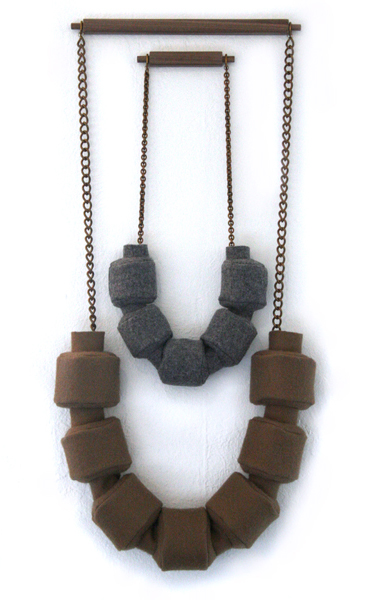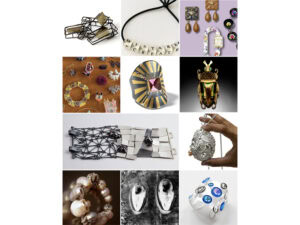
Susan Cummins: Your work is a blur of sculpture, craft, fiber, and jewelry. Would you explain your educational background?
Emily Bixler: I entered Pacific Northwest College of Art (Portland, Oregon) as a painter but quickly shifted focus after my first welding class. Form and the placement of objects in space mesmerized me. I started experimenting with installation and the way an entire room creates a composition. Sculpture opened up a whole world of materials and textures as well. The school I attended did not have a proper fiber department, however, so I would lug my sewing machine around with me to class. Post college I had several jobs that I sought out as opportunities to explore methods of craft—working in the knitwear industry, as a milliner’s assistant, seamstress, and jewelry designer.

Was there a particular teacher who influenced you? And was there a turning point in your work when you decided to blur the lines between practices?
Emily Bixler: David Eckard, my sculpture teacher in college, challenged and forever altered the way I think about the blending of materials and the power that an object can hold. Additionally, Dayna Pinkham of Pinkham Millinery encouraged and affirmed the importance of detail and fine craftsmanship. She informed me a great deal on what it takes to realize your passion and how to put it out into the world.
The blending of materials started after taking a few years off of knitwear design and working in jewelry production. I hadn’t been making art for several years, and I suppose I started being romanced by texture again. The necklaces kept getting bigger and bigger, and I became hungry for fiber. So I started knitting scarves with chains running through them and went on from there.
I suppose I wanted a different challenge. I found great pleasure in designing large-scale jewelry and working with drape on the body. When fiber was introduced, an entire investigation started on how tension conducts form.

Are some of the wall pieces, such as Shield, possible to wear?
Emily Bixler: The larger pieces are meant as extensions of the shape and pattern—not as exaggerated accessory. I refer to them as “wall necklaces.” After working with the smaller shapes to create composition on the body, I wanted to expand to a room-size format again.

Emily Bixler: It is two-fold really. Quite often one informs the other. With the large pieces, I take into account the materials, their age, connotation, and the inherent emotions held in the tension and drape of the forms. I don’t necessarily start with a poetic bend— the process tends to lead the way. The newer pieces that are housed in wooden mounts have taken on more meaning for me as t hey are clearly un-wearable. They take on an artifact type quality, and that really interests me. As if viewing a mask or piece of clothing, they are displayed as a posed possibility. Oftentimes, adornment can transport the wearer, and I have begun to understand the new work as a facilitator for the journey.

Emily Bixler: Portland is home to a thriving community of makers, now more than ever. It has been an amazing place to grow up in and to watch grow. I am probably a little biased as it is the school I attended, but Pacific Northwest College of Art (PNCA) has a fresh, vibrant community and is constantly expanding. I could go on and on about the growing number of galleries as well, but overall it is the relationship between the people working here that is most noteworthy. There is such a strong group of established and emerging artists in Portland, and we all come together to learn from and enhance each other. It is really an amazing place for that reason. With so many people making jewelry in this town, I think there is a healthy undercurrent of support and challenge. We are all encouraging each other to keep exploring.
Thank you.





